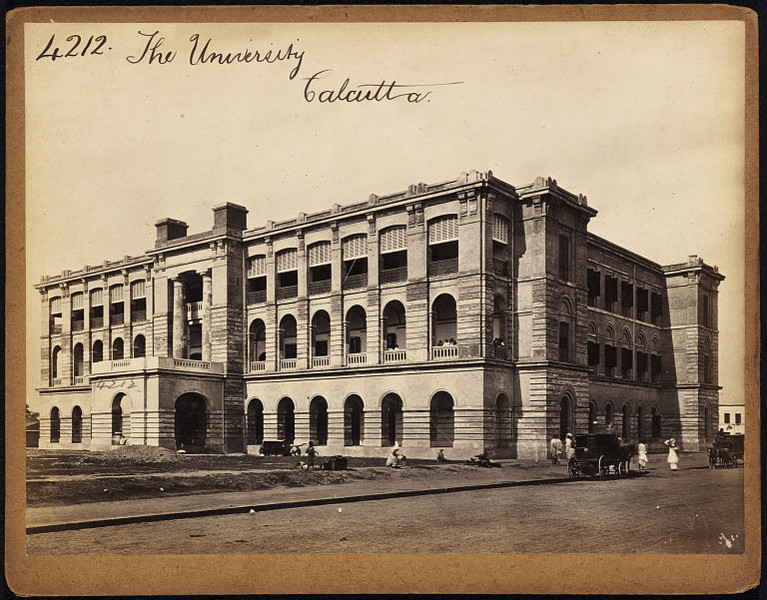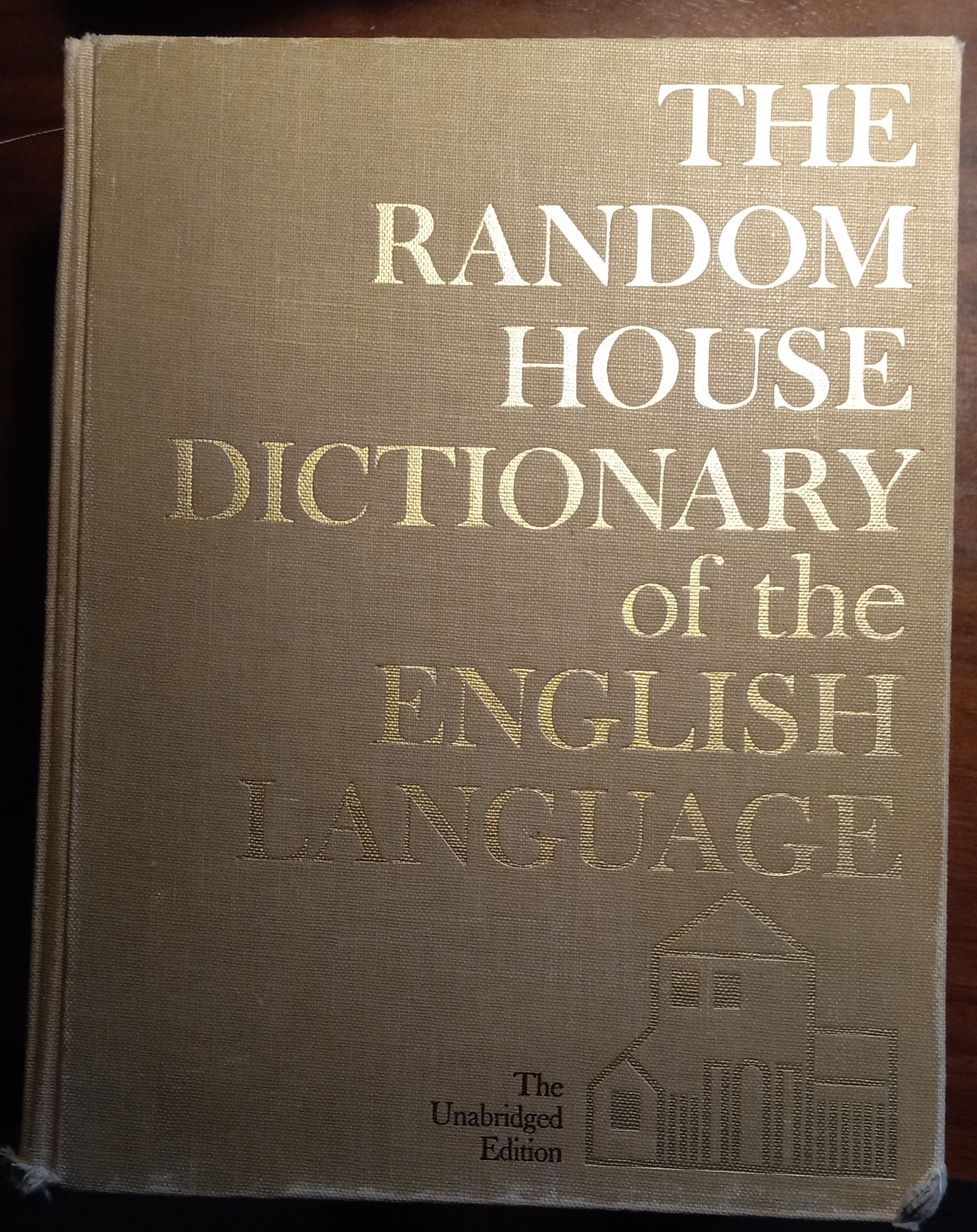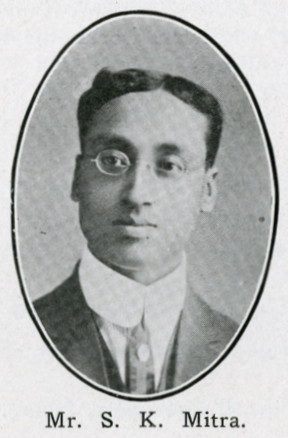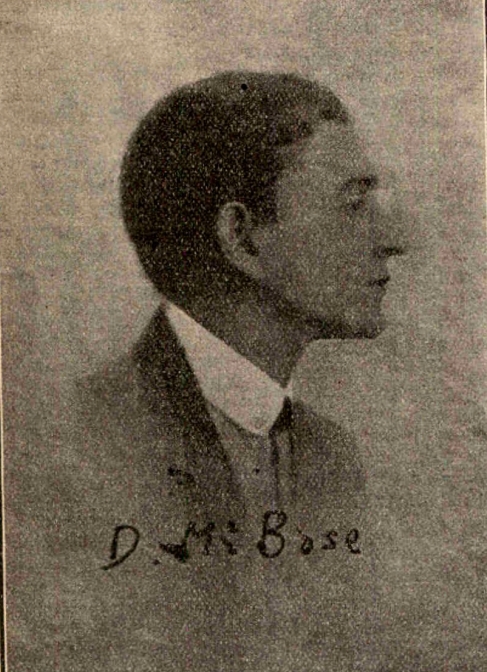|
Jagdish Chandra Bose
Sir Jagadish Chandra Bose (; ; 30 November 1858 – 23 November 1937) was a polymath with interests in biology, physics and writing science fiction. He was a pioneer in the investigation of radio microwave optics, made significant contributions to botany, and was a major force behind the expansion of experimental science on the Indian subcontinent. Bose is considered the father of Bengali science fiction. A crater on the Moon was named in his honour. He founded the Bose Institute, a premier research institute in India and also one of its oldest. Established in 1917, the institute was the first interdisciplinary research centre in Asia. He served as the Director of Bose Institute from its inception until his death. Born in Mymensingh, Bengal Presidency (present-day Bangladesh), during British governance of India, Bose graduated from St. Xavier's College, Calcutta (now Kolkata, West Bengal, India). Prior to his enrollment at St. Xavier's College, Calcutta, Bose attended Pabn ... [...More Info...] [...Related Items...] OR: [Wikipedia] [Google] [Baidu] |
Mymensingh
Mymensingh () is a metropolis, metropolitan city and capital of Mymensingh Division, Bangladesh. Located on the bank of the Old Brahmaputra River, Brahmaputra River, about north of the national capital Dhaka, it is a major financial center and educational hub of north-central Bangladesh. It is the administrative center of Mymensingh District and Mymensingh Division. As of 2022, Mymensingh City Corporation is the 7th largest city in terms of area and the 8th largest in terms of population in the country, with a population of 576,927 people. The city was constituted by the British East India Company on 1 May 1787. According to Ministry of Public Administration, Mymensingh is ranked 4th in district status. The population density of Mymensingh city is 44,458/km2 (115,150/sq mi), making it the second most densely populated city in Bangladesh. Mymensingh attracts 25 percent of all the Medical tourism, health tourists visiting Bangladesh. Mymensingh is an anglicization of the name ... [...More Info...] [...Related Items...] OR: [Wikipedia] [Google] [Baidu] |
University Of Calcutta
The University of Calcutta, informally known as Calcutta University (), is a Public university, public State university (India), state university located in Kolkata, Calcutta (Kolkata), West Bengal, India. It has 151 affiliated undergraduate colleges and 16 institutes in Kolkata and nearby areas. It was established on 24 January 1857 and is the oldest multidisciplinary university of Indian Subcontinent and Southeast Asian Region. Today, the university's jurisdiction is limited to a few districts of West Bengal, but at the time of its establishment it had a catchment area ranging from Kabul to Myanmar. It is accredited as an "A" grade university by the National Assessment and Accreditation Council (NAAC). The university has a total of fourteen campuses spread over the city of Kolkata and its suburbs. As of 2020, 151 colleges and 21 institutes and centres are affiliated with CU. The university was fourth in the Indian University Ranking 2021 list, released by the National Institu ... [...More Info...] [...Related Items...] OR: [Wikipedia] [Google] [Baidu] |
Frontline (magazine)
''Frontline'' is a fortnightly English language magazine published by The Hindu Group of publications headquartered in Chennai, India. Vaishna Roy is the editor of the magazine. It is a news and views magazine that provides in-depth coverage on various topics such as politics, world affairs, culture, science, health, business and personalities. ''Frontline'' gives coverage to developmental issues and issues related to the working classes, unorganized sectors, tribal regions and other under-served regions in India. History ''Frontline'' was first published in December 1984. It was originally intended to be a newspaper when it was started by the founders. They later had differences of opinion regarding the content and intent of the publication, and the magazine was sold to PL Investments Ltd, which later sold it to The Hindu Group. Contributors and perspective The magazine's long-serving editor was R. Vijaya Sankar, who retired in May 2022. The magazine's regular contributors ... [...More Info...] [...Related Items...] OR: [Wikipedia] [Google] [Baidu] |
Physics
Physics is the scientific study of matter, its Elementary particle, fundamental constituents, its motion and behavior through space and time, and the related entities of energy and force. "Physical science is that department of knowledge which relates to the order of nature, or, in other words, to the regular succession of events." It is one of the most fundamental scientific disciplines. "Physics is one of the most fundamental of the sciences. Scientists of all disciplines use the ideas of physics, including chemists who study the structure of molecules, paleontologists who try to reconstruct how dinosaurs walked, and climatologists who study how human activities affect the atmosphere and oceans. Physics is also the foundation of all engineering and technology. No engineer could design a flat-screen TV, an interplanetary spacecraft, or even a better mousetrap without first understanding the basic laws of physics. (...) You will come to see physics as a towering achievement of ... [...More Info...] [...Related Items...] OR: [Wikipedia] [Google] [Baidu] |
Biology
Biology is the scientific study of life and living organisms. It is a broad natural science that encompasses a wide range of fields and unifying principles that explain the structure, function, growth, History of life, origin, evolution, and distribution of life. Central to biology are five fundamental themes: the cell (biology), cell as the basic unit of life, genes and heredity as the basis of inheritance, evolution as the driver of biological diversity, energy transformation for sustaining life processes, and the maintenance of internal stability (homeostasis). Biology examines life across multiple biological organisation, levels of organization, from molecules and cells to organisms, populations, and ecosystems. Subdisciplines include molecular biology, physiology, ecology, evolutionary biology, developmental biology, and systematics, among others. Each of these fields applies a range of methods to investigate biological phenomena, including scientific method, observation, ... [...More Info...] [...Related Items...] OR: [Wikipedia] [Google] [Baidu] |
Polymath
A polymath or polyhistor is an individual whose knowledge spans many different subjects, known to draw on complex bodies of knowledge to solve specific problems. Polymaths often prefer a specific context in which to explain their knowledge, but some are gifted at explaining abstractly and creatively. Embodying a basic tenet of Renaissance humanism that humans are limitless in their capacity for development, the concept led to the notion that people should embrace all knowledge and develop their capacities as fully as possible. This is expressed in the term Renaissance man, often applied to the Intellectual giftedness, gifted people of that age who sought to develop their abilities in all areas of accomplishment: intellectual, artistic, social, physical, and spiritual. Etymology The word polymath derives from the Ancient Greek, Greek roots ''poly-'', which means "much" or "many," and ''manthanein'', which means "to learn." Plutarch wrote that the Ancient Greek Muses, muse P ... [...More Info...] [...Related Items...] OR: [Wikipedia] [Google] [Baidu] |
Random House Webster's Unabridged Dictionary
''Random House Webster's Unabridged Dictionary'' is a large American dictionary, first published in 1966 as ''The Random House Dictionary of the English Language: The Unabridged Edition''. Edited by Editor-in-chief Jess Stein, it contained 315,000 entries in 2256 pages, as well as 2400 illustrations. The CD-ROM version in 1994 also included 120,000 spoken pronunciations. History The Random House publishing company entered the reference book market after World War II. They acquired rights to the ''Century Dictionary'' and the ''Dictionary of American English'', both out of print. Their first dictionary was Clarence Barnhart's ''American College Dictionary'', published in 1947, and based primarily on ''The New Century Dictionary'', an abridgment of the ''Century''. In the late 1950s, it was decided to publish an expansion of the ''American College Dictionary'', which had been modestly updated with each reprinting since its publication. Under editors Jess Stein and Laurence Urdan ... [...More Info...] [...Related Items...] OR: [Wikipedia] [Google] [Baidu] |
Meghnad Saha
Meghnad Saha (6 October 1893 – 16 February 1956) was an Indian astrophysicist and politician who helped devise the theory of Thermal ionization, thermal ionisation. His Saha ionization equation, Saha ionisation equation allowed astronomers to accurately relate the Stellar classification, spectral classes of stars to their actual temperatures. Biography Meghnad Saha was born on 6 October 1893 to a lower-caste Bengali Hindu family in the village of Kaliakair Upazila, Sheoratali in Gazipur District, Gazipur, then part of the Dhaka Division, Dacca district of the Bengal Presidency (now Bangladesh). He was the fifth of eight children born to Jagannath Saha, a poor shopkeeper, and his wife, Bhubaneshwari Devi. Due to the superstitious religious ideologies of the orthodox haughty Brahmins of the time and his childhood and career experiences of casteism, Saha developed a hatred for Hinduism from a young age. During his youth, he was forced to leave Dhaka Collegiate School because h ... [...More Info...] [...Related Items...] OR: [Wikipedia] [Google] [Baidu] |
Sisir Kumar Mitra
Sisir Kumar Mitra (or ''Shishirkumar Mitra'') MBE, FNI, FASB, FIAS, FRS (24 October 1890 – 13 August 1963) was an Indian physicist. Early life and education Mitra was born in his father's hometown of Konnagar, a suburb of Kolkata (then Calcutta) located in the Hooghly District in the Bengal Presidency (present-day West Bengal). He was the third son of Joykrishna Mitra, who was a schoolteacher at the time of Mitra's birth, and Saratkumari, a medical student whose family came from Midnapore. While Mitra's paternal family were orthodox Hindus, his mother's family were adherents of the progressive Brahmo Samaj, and were noted in Midnapore for their advanced outlook. In 1878, Joykrishna Mitra had joined the Brahmo Samaj and married his wife, against the wishes of his family, who responded by severing ties with him. As a consequence, the newly wed couple moved to Saratkumari's hometown of Midnapore, where Joykrishna and his wife had two sons – Satish Kumar and Santosh Kum ... [...More Info...] [...Related Items...] OR: [Wikipedia] [Google] [Baidu] |
Prasanta Chandra Mahalanobis
Prasanta Chandra Mahalanobis OBE, FNA, FASc, FRS (29 June 1893 – 28 June 1972) was an Indian scientist and statistician. He is best remembered for the Mahalanobis distance, a statistical measure, and for being one of the members of the first Planning Commission of free India. He made pioneering studies in anthropometry in India. He founded the Indian Statistical Institute, and contributed to the design of large-scale sample surveys. For his contributions, Mahalanobis has been considered the Father of statistics in India. Since 2007, every year June 29 is celebrated as National Statistics Day in India to commemorate the birth anniversary of P.C. Mahalanobis and his contributions to statistical science and planning. Early life Mahalanobis was born on 29 June 1893, in Calcutta, Bengal Presidency (now West Bengal). Mahalanobis belonged to a prominent Bengali Brahmin family of landed gentry in Bikrampur, Dhaka, Bengal Presidency (now in Bangladesh). His grandfather Guruchar ... [...More Info...] [...Related Items...] OR: [Wikipedia] [Google] [Baidu] |
Satyendra Nath Bose
Satyendra Nath Bose (; 1 January 1894 – 4 February 1974) was an Indian theoretical physicist and mathematician. He is best known for his work on quantum mechanics in the early 1920s, in developing the foundation for Bose–Einstein statistics, and the theory of the Bose–Einstein condensate. A Royal Society#Fellows, Fellow of the Royal Society, he was awarded India's second highest civilian award, the Padma Vibhushan, in 1954 by the Government of India. The class of particles that obey Bose statistics, bosons, was named after Bose by Paul Dirac. A polymath, he had a wide range of interests in varied fields, including physics, mathematics, chemistry, biology, mineralogy, philosophy, The arts, arts, literature, and music. He served on many research and development committees in India, after independence. Early life Bose was born in Calcutta (now Kolkata), the eldest of seven children in a Bengali Kayastha family. He was the only son, with six sisters after him. His ance ... [...More Info...] [...Related Items...] OR: [Wikipedia] [Google] [Baidu] |
Debendra Mohan Bose
Debendra Mohan Bose (D. M. Bose) (26 November 1885 – 2 June 1975) was an Indian physicist who made contributions in the field of cosmic rays, artificial radioactivity and neutron physics. He was the longest serving Director (1938–1967) of Bose Institute. Bose was the nephew of the famous physicist Jagadish Chandra Bose, who laid the foundations of modern science in India. Early life Debendra Mohan Bose was born in Calcutta (present day Kolkata) in a famous Brahmo family. He was the youngest son of Mohini Mohan Bose, one of the first Indians to proceed to USA to qualify himself in field of homeopathy. Ananda Mohan Bose was his paternal uncle, while Jagadish Chandra Bose was his maternal uncle. After his father's untimely death, Debendra's education was supervised by his uncle J. C. Bose. Debendra's plan of getting a degree in engineering from the Bengal Engineering College, Shibpur was cut short when he suffered a severe malaria attack. Nobel laureate Rabindranath Ta ... [...More Info...] [...Related Items...] OR: [Wikipedia] [Google] [Baidu] |










